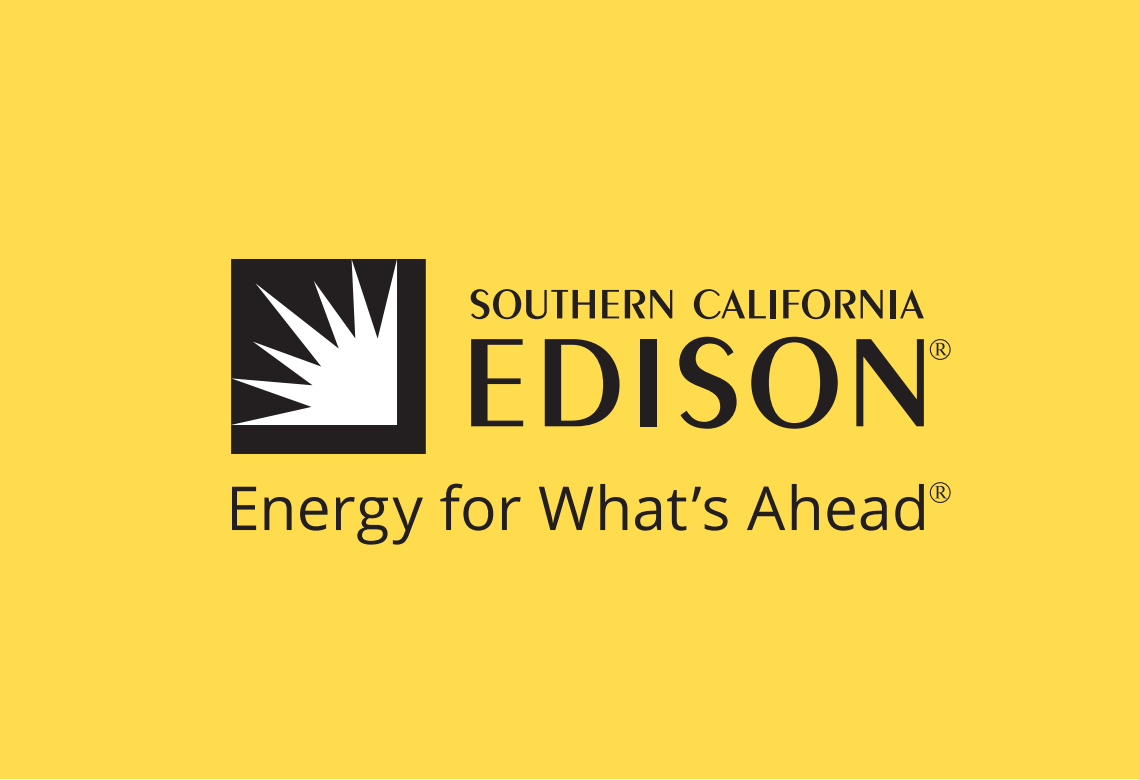

Answers to Frequently Asked Questions
General Program FAQs
What is the Emergency Load Reduction Program (ELRP)?
ELRP is a seven-year pilot (2021-2027) providing incentives for incremental load reduction during times of high grid stress and emergencies, while minimizing costs to ratepayers.
What is the eligibility?
To be eligible to participate, non-residential (commercial, industrial, and agricultural) individual bundled-service customers must be able to reduce load by a minimum of one kilowatt during an ELRP event, have an SCE-approved interval meter or SmartConnect™ meter that can measure energy consumption, at least hourly, and if applicable, can measure exported energy.
How do I enroll in ELRP?
To enroll, visit elrp.sce.com. You will need your service account number to enroll, which is located on the first page of your bill. After you have completed the online ELRP Application, SCE or Olivine may contact you with some follow up questions.
Can I participate in other DR Programs?
In most instances, dual participation with ELRP is permitted with the following DR programs:
- Time-Of-Use Base Interruptible Program (BIP)
- Agricultural and Pumping Interruptible (AP-I) program
- Critical Peak Pricing (CPP)
- Real-Time Pricing (RTP)
- Summer Discount Plan (SDP-C only)
Bidding FAQs
What is an Energy Bid?
An Energy Bid is the amount of energy in kilowatts (kW) you commit to reducing during each hour of an ELRP event.
How and when do I submit an Energy Bid?
Energy bids are submitted via the ELRP Application when you first enroll in the program.
Can a bid be applied retroactively?
Bids cannot be applied retroactively. Bids can only be placed for future events.
Will my Energy Bid affect my incentive?
No, you will be compensated for your actual load reduction even if it is less or more than your Energy Bid.
Participation and Incentive FAQs
How much will I earn if I participate?
You can receive an annual bill credit for energy reductions. You will receive a credit of $2 per kilowatt per hour (kWh) or $2,000 per megawatt per hour (MWh) of net incremental load reduction during an event.
Are there penalties for not reducing my energy usage during an ELRP event?
No, there are no penalties if you are not able to participate in an event.
What if I am enrolled in more than one DR program?
If you are enrolled in more than one DR program and more than one event is called on the same day, you can participate in both events and may earn credits/incentives under both programs. However, if the events occur at the same time, you will only receive credits/incentives for one program during periods of overlap—provided you meet the program’s incentive thresholds. When you dual participate, ELRP will serve as your secondary incentive option.
How will my ELRP load reduction be calculated?
Load reduction is based on the difference between your energy baseline usage and your actual usage (positive and negative) during an ELRP event; this is considered your Incremental Load Reduction (ILR). There are exceptions, such as BIP-ELRP dual participants, whose energy baseline is their BIP FSL.
How is my baseline calculated?
Your 10-Day Customer Specific Energy Baseline (CSEB) is calculated by averaging the usage for the same hour from the last ten (10) similar days before the Event Day. For this example, an ELRP event occurred on August 14 (Friday) and began at 5 p.m.
Under this baseline methodology, the same hour from the 10 similar days prior to the Event Day is averaged (by service account) to establish the hourly average baseline. The previous 10 days exclude days when an ELRP event occurred.
For customers that are dual enrolled in ELRP and a second DR program, the previous 10 days will exclude days when any DR events occurred. For events on weekends and holidays, you use a 4-day similar day baseline.
What is the Day of Adjustment (DOA)?
The DOA option may help some customers receive greater incentives by adjusting their baseline, if they are able to shift their load/energy usage to the morning of an event and then reduce usage during event hours. If the usage for the morning of the event is higher than the baseline, the credits will be greater with the DOA applied. The DOA value cannot be less than 1.00 or greater than 1.40.
Use the following steps to determine the DOA Ratio:
- Determine your Event Day Usage by taking the total kWh usage of the first three of four hours prior to the Event Start on the Event Day. Divide the total by 3.
- Determine your Previous 10-Day Usage by taking the total kWh usage for the same 3 hours during the 10 days prior to the Event Day. Divide the total by 30.
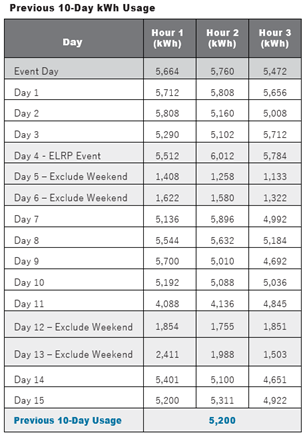
3.Calculate your DOA Ratio by dividing your Event Day Usage by your Previous 10-Day Usage.
Please contact your SCE Account Manager or SCE’s third-party program administrator’s (Olivine) Help Desk at 1-833-227-2580 for more details.
Can CCA and DA customers participate in ELRP?
Yes, CCA and DA customers can participate if they meet the program requirements.
ELRP Event FAQs
When can an ELRP event be called?
Events may be called May 1 to October 31, but are limited to:
- 4 p.m. to 9 p.m.
- Any day of the week (Sun-Sat), including holidays
An ELRP event can be called on a day-ahead or a day-of basis after an Energy Emergency Alert (EEA) is issued by the California Independent System Operator (CAISO), such as an EEA Warning, EEA-1, EEA-2, or EEA-3.
Will I receive a notification when an ELRP event is scheduled?
Yes. You may request courtesy alerts to help you plan for an interruption event. Notifications may be sent via email and/or text at the time of enrollment.
For added convenience, you may also download our free SCE Demand Response (DR) Alerts mobile app (available from the App Store or Google Play) to have notifications delivered straight to your smartphone.
For example, if you are dual enrolled in BIP and ELRP, when you participate in overlapping DR events, you will not be assessed excess energy charges if you reduce your energy usage to or below your BIP Firm Service Level (FSL). If you do not meet your preselected BIP FSL, you are not eligible to earn ELRP incentives. Also, per the program rules, BIP customers can only earn ELRP incentives for load reductions below their FSL for ELRP event hours that overlap with BIP event hours.
For customers dual-enrolled in AP-I or SDP-C and ELRP, when you participate in overlapping DR events, you will not be eligible for ELRP incentives. But you can earn ELRP incentives when ELRP events do not overlap with your AP-I or SDP-C events.
For customers dual-enrolled in CPP or RTP and ELRP, when you participate in ELRP events, you can earn ELRP incentives for your incremental load reduction (e.g., reduction below your energy baseline). CPP events will not be excluded from your energy baseline calculation.
When will I receive my bill credit?
Earned bill credits are accumulated during the summer season and applied in the first quarter of the following year.
Can I use my back-up generator (BUG) during an ELRP event?
The California Public Utilities Commission (CPUC) prohibits certain fossil-fueled generation resources to be used for load reduction during Demand Response (DR) events but makes certain exceptions for ELRP. Prohibited Resources include distributed generation technologies using diesel, natural gas, gasoline, propane, or liquefied petroleum gas, in topping cycle Combined Heat and Power (CHP) or non-CHP configuration.
BUGs not utilizing Prohibited Resources can be used during an ELRP event. Prohibited Resources can only be used during ELRP events when permitted by a Governor’s Executive Order. ELRP customers located in a DAC cannot use Prohibited Resources under the current program rules, unless specifically overridden by a Governor’s Executive Order. Under emergency situations, it is unclear what regulations, if any, may be lifted by a Governor’s Order to meet grid reliability needs. SCE will follow applicable CPUC and/or Governor orders.
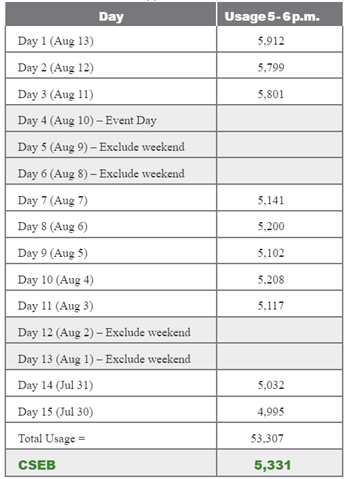

How are annual bill credits calculated?
Use the following steps to calculate your Earned Bill Credits.
Calculate your Adjusted Customer Specific Energy Baseline (ACSEB) by multiplying your CSEB by your DOA Ratio.

Calculate your Incremental Load Reduction (ILR) event total by subtracting your Hourly Usage, per event hour, from your ACSEB.

Calculate your Earned Bill Credit* by multiplying your ILR Event Total by the per kWh base credit of $2.
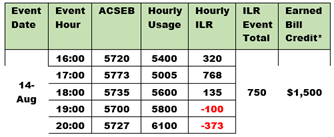

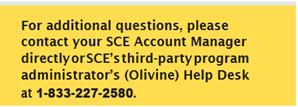
This FAQ is meant to be an aid to understanding SCE’s programs and pricing schedules. It does not replace the CPUC-approved ELRP Terms & Conditions. *Earned Bill Credit is estimated. Actual credit will be based upon event performance.
©2024 Southern California Edison.

